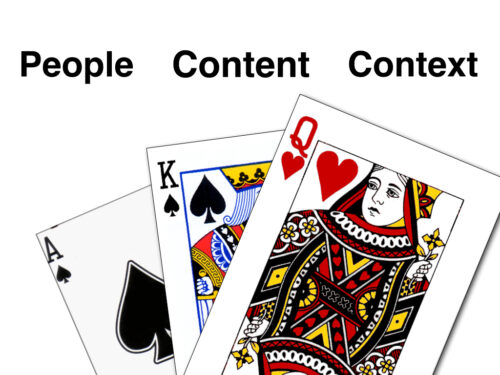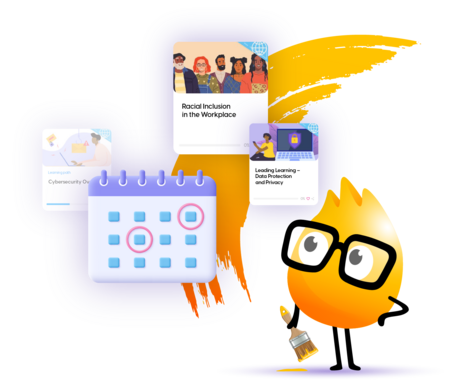The Training Trifecta: People Content and Context
If content is king, then context is queen. Long live the queen!
Understanding the context of work performance is critical to all aspects of a learning solution. So keep it simple. It’s easy to know who your audience is, or to learn who they are. And equally as easy to figure out what content is most likely required by that audience. But understanding how someone uses the content and knowledge you give them is a little more complicated.
But before I get ahead of myself, let’s identify each of these elements.
People
You’re probably getting ready to skip this section. Not so fast, cowboy! People are important. After all, it’s those people that keep us people, training people, employed. So, let’s take care of them and give them our best.
For some of you, understanding the people you impact is as simple at knowing that you are a trainer of sales people. And since you may have been a sales person yourself, then understanding the average sales person makes this part of your job a slam dunk. Good on ya. But I’m certain many of you are confronted with the very real world of training people whom you have no idea what they do…or why they would do it. Do not despair because this exactly what you signed on for. You love learning new stuff. You love the unknown and those who dwell there. Embrace the learning moments here because that buzz will need to carry you through the hard times.
If you are creating customer training you will generalize who is most likely to be consuming your content. But if you are responsible for creating internal employee training, like on-boarding programs then you will have an opportunity to get much more detail. Get the information, but don’t forget to build relationships with everyone you meet. Learning has become a full contact sport with everyone acting as their own quarterback. And if you hope to influence their learning process then collaboration is the name of the game.
Content
While getting to know your people, a picture will likely begin to form. Within that picture you will see the content they have, need, and want. And yes, understanding what they already know is just as important as what they need to know. Why? Because the next person you talk too may need the content they have. And instantly you’ve connected two people, positively impacted them both, and are one step closer to super hero. Okay, maybe not super hero, but definitely you’ve upped your value from training dude, to knowledge broker.
Don’t underestimate the power of training content, and knowledge, within the walled corporate castle. Knowledge and content is as good as gold, and there are the haves, and the have nots. A good knowledge broker understands the people well enough to broker the deals that gets the knowledge from the haves to the have nots. Oh, wait. Let me clarify my analogy. Everyone has something they know… a have. And everyone needs to learn something… a have not. So broker the deals by meeting everyone’s needs, getting it to them at the right place and at the right time. And with that, friends, I give you…context.
Context
The right place, right time, and right format. This is context. And this is not easy. So not easy, in fact, if you are not careful you’ll be introducing your forehead to the top of your desk one too many times. This is where your life becomes filled with thought leaders, vendors (that’s me…but I’m cool.), authoring tools, and strange newly invented words and phrases like mLearning, SoLoMo, performance support, instructional design philosophizations, and enterprise full frontal contextually appropriate brain-based learning ecosystems. Okay, yeah, I made that last one up. But damn, I probably really did read that in some academic bladibla journal.
Once you get past all of that…stuff, you will find yourself wondering why there just isn’t a simple way to get this work done. We all end up at that point sooner or later. So, here are some quick tips about context:
- Get to know what enterprise systems your people use in their daily workflow…and yeah, get to know the workflow, duh!
- Do your people use mobile devices? Is there consistent connectivity?
- Is there already a corporate library of some sort? Find it.
- If your company makes a product then by all means get to know the tech writers.
- And I can’t say enough about connecting with your marketing department. They have all the money and creative resources.
That’s just 5 quick things off the top of my head. You get the idea. Context is everything about the environment that holds the people you need to provide a service too. So get to know everything about that environment every bit as much as the people and the content.
Is there something about training that doesn’t fit into the People/Content/Context model? Let me know what you think.






